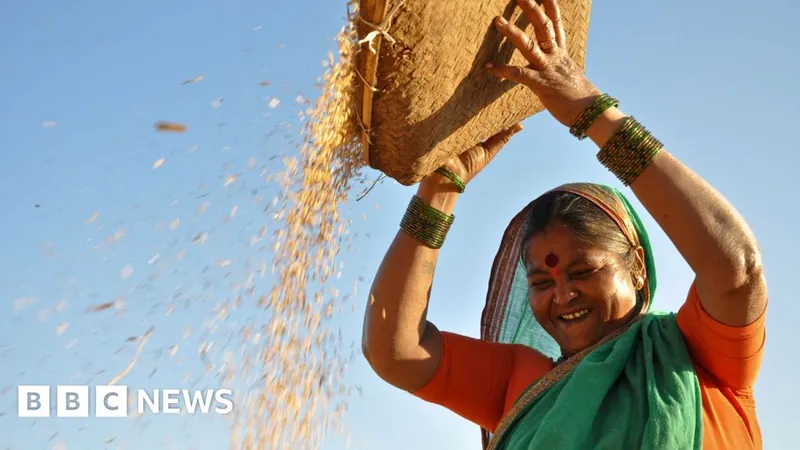
U.S.-India Trade Tensions: Can Agriculture Bridge the Gap?
2025-03-30
Author: Olivia
Introduction
In a provocative statement, U.S. Commerce Secretary Howard Lutnick recently questioned why India wouldn't purchase even a single bushel of American corn, highlighting what he perceives as restrictive trade policies in India. His remarks reflect the growing tensions in the U.S.-India trade relationship, particularly as agriculture becomes a focal point in President Donald Trump’s escalating trade war.
Context of Trade Tensions
Set to escalate with reciprocal tariffs beginning April 2, the U.S. has accused India of being a “tariff king” and a significant abuser of trade practices. Washington has long sought greater access to India’s agricultural market—a potential goldmine for U.S. farmers—but India’s government staunchly defends its trade barriers, citing agricultural self-sufficiency, food security, and the welfare of millions of small farmers.
India's Agricultural Progress
India’s transition from food insecurity to a robust agricultural economy is a remarkable achievement and a story of resilience. In decades past, the country relied heavily on food imports and aid. However, agricultural advancements have allowed India to not only feed its 1.4 billion people but also emerge as the world's largest producer of milk and a major exporter of various agricultural products.
Current Challenges
Despite this success, the Indian agriculture sector is fraught with challenges, including low productivity, inadequate infrastructure, and insufficient market access. Additionally, while half of India’s workforce is employed in agriculture, this sector accounts for only about 15% of the country's GDP—a stark contrast to the less than 2% of the U.S. population engaged in farming.
Impact of Tariff Policies
High tariffs on imports are a significant feature of India's trade policies, established to protect local farmers from foreign competition. The tariff structure in India is quite severe, with average rates reaching as high as 37.7% on U.S. agricultural imports, compared to the mere 5.3% average on Indian goods entering the U.S. This has created a modest bilateral trade relationship valued at around $8 billion, with India exporting primarily rice, shrimp, and spices while importing nuts and fruits from the U.S.
Ambitions for Agricultural Exports
However, U.S. officials have expressed ambition for more substantial agricultural exports, particularly staple crops like wheat and corn, aiming to address a staggering $45 billion trade deficit with India. Experts argue that pushing for reduced tariffs and a regulatory easing regarding genetically modified crops could threaten small farmers in India, who often cannot compete against heavily subsidized U.S. agriculture.
Internal Struggles
The challenges are not only externally sourced; many of agriculture's struggles in India stem from underfunding and insufficient investment. Historically, agriculture has received less than 6% of India's total investment, showing an urgent need for funds that could go toward vital infrastructure and technology.
Farmers' Struggles and Protests
The need for change has never been more pressing. Farmers in India have faced considerable hardships; protests have emerged calling for better pricing and minimum support guarantees from the government. As these farmers grapple with economic realities, the challenge of negotiating favorable agreements with the U.S. will necessitate a balancing act between the interests of American agribusiness and India's farmers.
Experts' Recommendations
Moving forward, experts suggest that India should remain resolute against U.S. pressure to fully open its agriculture sector to foreign competition, which could jeopardize local livelihoods and food security. The focus should instead be on modernizing the agricultural framework, enhancing productivity, and increasing competitiveness in global markets.
Future Outlook
Some believe that with the right investments and strategies, India could produce a surplus that would bolster both domestic food security and position the nation as a leading player in global agricultural trade.
Conclusion
In the intricate game of global trade, timing and strategic negotiations will be crucial. India’s ability to engage in these discussions while firmly protecting its rural economy could determine the future of its agricultural sector. As the clock ticks toward impending tariffs, the world watches how this high-stakes trade drama unfolds—will it promote prosperity or perpetuate conflict?









 Brasil (PT)
Brasil (PT)
 Canada (EN)
Canada (EN)
 Chile (ES)
Chile (ES)
 Česko (CS)
Česko (CS)
 대한민국 (KO)
대한민국 (KO)
 España (ES)
España (ES)
 France (FR)
France (FR)
 Hong Kong (EN)
Hong Kong (EN)
 Italia (IT)
Italia (IT)
 日本 (JA)
日本 (JA)
 Magyarország (HU)
Magyarország (HU)
 Norge (NO)
Norge (NO)
 Polska (PL)
Polska (PL)
 Schweiz (DE)
Schweiz (DE)
 Singapore (EN)
Singapore (EN)
 Sverige (SV)
Sverige (SV)
 Suomi (FI)
Suomi (FI)
 Türkiye (TR)
Türkiye (TR)
 الإمارات العربية المتحدة (AR)
الإمارات العربية المتحدة (AR)